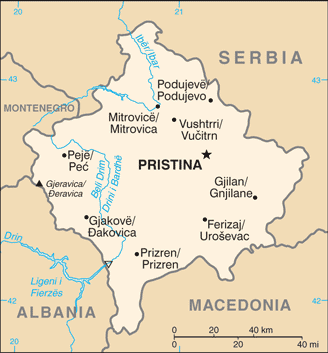 Kosovo
Kosovo
History
The Illyrian tribe of Dardanae was the first to inhabit the present-day region of Kosovo in the Neolithic period. After a period of rule by the Romans, a Serbian ruler annexed the area at the end of the 12 th century. At the Battle of Kosovo in 1389, the Ottoman Turks inflicted heavy casualties on the Serbian army and eventually gained control of all of Serbia by 1459. Kosovo remained an Ottoman territory until 1912, when it became part of the newly independent state of Albania. One year later, however, the Great Powers—Austria-Hungary, France, Britain, Germany, Italy, and Russia—forced Albania to cede Kosovo to Serbia. In 1918, it was incorporated into the newly formed Kingdom of the Serbs, Croats, and Slovenes, which later became Yugoslavia.
In 1946, Kosovo became an autonomous province within Serbia. Tensions between ethnic Albanians (the majority of the population) and Serbs mounted as the Albanians continued to agitate for secession from Serbia, seeking either union with Albania or outright independence. Most of province’s Albanian inhabitants support the independence movement, while Serbs fear it would be a preliminary to further ethnic cleansing and the formation of a “Greater Albania”. The Kosovo parliament issued a resolution supporting independence since the “political will of Kosovo people for independence is non negotiable”. In the meantime, the Serbian cabinet adopted a resolution opposing full independence for Kosovo
Kosovo declared it's independence in February of 2008 and is made up of a parliament system with the prime minister being the one in power.
Church History
Between March 1998 and April 1999, over half a million people were forced out of Kosovo, a region in the former Federal Republic of Yugoslavia (FRY), during fierce fighting between ethnic Albanians and Serbs. Most fled to neighboring Albania and Macedonia. In Albania, the Assemblies of God operated refugee camps, and other relief agencies helped provide these camps with food, blankets, and medical and hygienic supplies. Besides meeting the basic physical needs of these refugees, however, AG missionaries also ministered to spiritual needs by sharing the gospel, reading the Bible, and praying with the refugees. Many refugees became believers and returned to Kosovo after the war with newfound faith and hope. These new Christians formed the nucleus of the Assemblies of God church in Kosovo.
Although the war is over, ethnic tensions persist. The Kosovar church has endured persecution, poverty, and war, but young evangelists and pastors continue to emerge out of this vibrant group of believers. The church is growing and thriving despite all obstacles. Many more churches have been established since the war, including the Community Fellowship Center of the Assemblies of God, which opened its doors in April of 2001. Located in Mitrovica, a city near the Serbian border, this Pentecostal fellowship, along with many others, hopes to bring healing and hope to a city, and a region, that has so long been divided.
The Movement Today
Today there are 3 Assembly of God churches with about 50 members and adherents
Additional Facts About Kosovo
- Capitol: Pristina
- Area: 4,212 square miles
- Population: 1.9 million
- Languages: Albanian, Serbian
- Agriculture: Corn, wheat, barley, potatoes, plums, grapes, and tobacco
- Industry: Agriculture, winemaking, timber, mining




